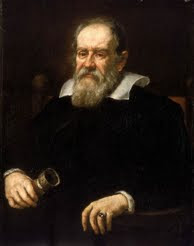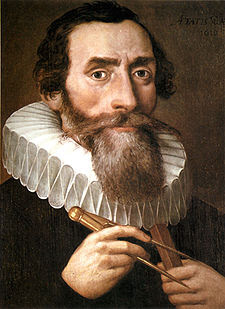
By the fall, he began using it for astronomical observations. He designed a series of successively better telescopes, giving him the ability to discern smaller details of the night sky than anyone before him. This opened up a gold rush of scientific exploration. Galileo was able to make astronomical discoveries very fast, but such discoveries could sometimes take months or years to verify, which left him with a dilemma: If he announced his discovery immediately, he could eventually turn out to have made a mistake; if he waited, one of his competitors might find the same thing and get the credit. Galileo's solution (and possibly one already in use by other scientists) was to write a short description of his findings, rearrange the letters, and distribute the coded version. In that way, he could reveal his conclusions at any time in the future.
In 1610, he sent letters to his fellow scientists, containing the following string of letters:
smaismrmilmepoetaleumibunenugttauirasFellow astronomer, Johannes Kepler
 anagrammed very hard and came up with this solution:
anagrammed very hard and came up with this solution: Salve umbistineum geminatum Martia proles.which translates to "Be greeted, double knob, offspring of Mars", and which Kepler interpreted to mean that Galileo had discovered that Mars has two moons, something that Kepler had predicted. But it turned out that Kepler's anagram was not the one that Galileo had had in mind. Allegedy the Holy Roman Emperor became interested in Galilelo's finding, and so Galileo finally revealed the actual original sentence to be
Altissimum planetam tergeminum observavi.which translates roughly to "I have observed the most distant of planets (Saturn) to have a triple form" (where U and V are treated as interchangeable in Latin). Galileo thought that he had observed two moons orbiting Saturn. He was wrong, as Huygens showed in 1656 that what Galileo had seen was actually a ring around Saturn. Huygens wrote an anagram about this, too.
In December of 1610, Galileo made an even bigger discovery which he transmitted as a true anagram:
Haec immatura a me iam frustra leguntur oy.which, translated, means roughly "This was already tried by me in vain prematurely". Kepler pleaded with him to reveal what he had found, and so in January, Galileo replied with the unanagrammed sentence:
Cynthiae figuras aemulatur Mater Amorum.Translation: "The Mother of Loves [Venus] imitates the figures of Cynthia [the Moon]." by which Galileo meant that Venus cycles through phases, just like the Moon. He had observed that Venus is not a light source - it simply reflects light from the Sun. And from the way it waxed and waned like the Moon, he could tell that Venus was orbiting the Sun. At a time when many held that everything revolved around the Earth, this was an amazing result.
In the 1670s, Robert Hooke was studying the physics of springs. He found that when you stretch a spring, the force that it pulls back with is proportional to the distance that you pull it. This came to be known as Hooke's Law. Hooke encrypted this in a popular way among scientists of the time: He simply alphabetized the letters and got "ceiiinosssttuv". The unscrambled version is "Ut tensio sic vis." which he revealed a few years later to mean "As the extension, so the force.".
Hooke held on to another discovery much longer. In 1671, he announced to the Royal Society of London (a group of scientists, dedicated to advancing scientific knowledge) that he had figured out what the optimal shape for the arch of a bridge was. Four years later, he published the encoded form of his conclusion:
 The unanagrammed form was not revealed until after he died in 1703(!). It read "As hangs a flexible cable, so inverted, stand the touching pieces of an arch." which means that if you hang a chain between two poles, you get a special curve called a catenary, and if you turn it upside down, this is the best shape for supporting a bridge.
The unanagrammed form was not revealed until after he died in 1703(!). It read "As hangs a flexible cable, so inverted, stand the touching pieces of an arch." which means that if you hang a chain between two poles, you get a special curve called a catenary, and if you turn it upside down, this is the best shape for supporting a bridge.I am guessing that the practice of anagramming conclusions in this way gradually disappeared as more formal publication methods were developed (the earliest probably being the journals published by the Royal Society of London starting in 1665).
In a way, this kind of encryption was not so different from the seeking of metaphysical truth through anagramming (as covered in a previous post), except that the scientists were deliberately putting the distilled form of the truth on the other end of the anagram and letting people search for it.
For more background on Galileo and his anagrams, you can read http://www.mathpages.com/home/kmath151.htm.
For more about Hooke's law and his caternary findings, see: http://www.lindahall.org/events_exhib/exhibit/exhibits/civil/design.shtml.
And for a fictionalized account of 17th century science and the development of the Royal Society (among other things), try Neal Stephenson's Baroque Cycle.

![If I stay there can be no party. I must be out there in the night, staying vigilant. Wherever a party needs to be saved, I'm there. Wherever there are words that need anagramming, I'm there. But sometimes I'm not because I'm out there in the night staying vigilant, watching, lurking, running, jumping, hurdling, sleeping. No, I can't sleep. You sleep. I'm awake. I don't sleep. I don't blink. Am I a bird? No. I'm a banana. I am Bananagrammer. Or am I? Yes, I am Bananagrammer. [applies chapstick]](https://blogger.googleusercontent.com/img/b/R29vZ2xl/AVvXsEgI5Yf53B1clpF3cLb11zYrIhaMn1Grv8uDvAhy_9vwjTU-CZCcX5MYmPwX-TnSagBaWwvJpIWeVsOP3q4r6k_HYnuRcVAOou4fwCkkVU7Or2NXmaWfZS6CjtkPnaeIdq3-wvdOC2DJb-Ra/s400/BGR-plot-medium.png)
